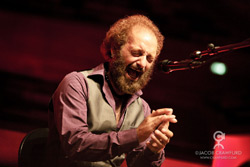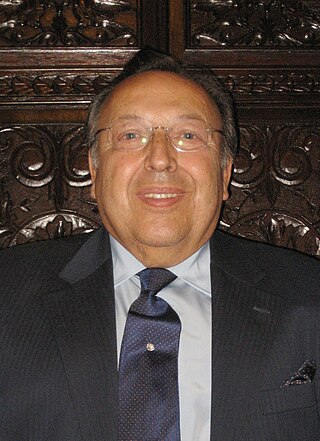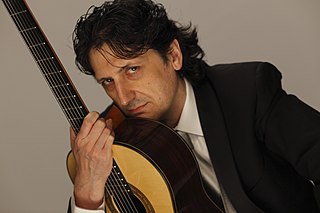Diego Carrasco (born in 1954 in Jerez de la Frontera, Spain) is a Spanish flamenco guitar player, composer and singer ( cantaor ).
Contents

Diego Carrasco (born in 1954 in Jerez de la Frontera, Spain) is a Spanish flamenco guitar player, composer and singer ( cantaor ).

He started at the age of 13 years old as "Tate de Jerez", playing guitar to artists like Ana la Piriñaca, tío Gregorio Borrico, Terremoto de Jerez, Manolo Soler or Sernita de Jerez; and to dancers like Alejandro Vega y Antonio Gades.
In 1984 his first album as singer is recorded, and he start a personal way to understand flamenco fusion with other musics.


Flamenco is an art form based on the various folkloric music traditions of southern Spain, developed within the gitano subculture of the region of Andalusia, and also having historical presence in Extremadura and Murcia. In a wider sense, the term is used to refer to a variety of both contemporary and traditional musical styles typical of southern Spain. Flamenco is closely associated to the gitanos of the Romani ethnicity who have contributed significantly to its origination and professionalization. However, its style is uniquely Andalusian and flamenco artists have historically included Spaniards of both gitano and non-gitano heritage.
The Music of Andalusia encompasses a range of traditional and modern musical genres which originate in the territory of Andalusia in southern Spain. The most famous are copla and flamenco, the latter being sometimes used as a portmanteau term for various regional musical traditions within Andalusia. Today, Andalusia has a rich and thriving musical scene, which draws from its own musical traditions as well as from external influences such as salsa, jazz or pop music.

Moraíto Chico was a Flamenco guitarist.

Vicente Amigo Girol is a Spanish flamenco composer and guitarist, born in Guadalcanal near Seville. He has played as an accompanying guitarist on recordings by flamenco singers Camarón de la Isla, and Luis de Córdoba, and he has acted as a producer for Remedios Amaya and José Mercé. His album Ciudad de las Ideas won the 2001 Latin Grammy for the Best Flamenco Album and the 2002 Ondas award for the best Flamenco work.
New flamenco or flamenco fusion is a musical genre that was born in Spain, starting in the 1980s. It combines flamenco guitar virtuosity and traditional flamenco music with musical fusion.

María del Rocío Mohedano Jurado, better known as Rocío Jurado, was a Spanish singer and actress. She was born in Chipiona (Cádiz) and nicknamed "La más grande".

Enrique Morente Cotelo, known as Enrique Morente, was a Spanish flamenco singer and a celebrated figure within the world of contemporary flamenco. After his orthodox beginnings, he plunged into experimentalism, writing new melodies for cante and jamming with musicians of all styles, without renouncing his roots in traditional flamenco singing, which he kept on cultivating despite criticism.
"It hasn't been easy. First came the accusations of corruption of the music, of treachery in his struggle to disfigure what was already perfectly coded. When some albums and some categorical evidence of his knowledge of the classical approach laid these malicious comments bare, then came the most twisted condemnations. That the pace of the compás waned, that he didn't really make you feel and that kind of thing."
The cante flamenco, meaning "flamenco singing", is one of the three main components of flamenco, along with toque and baile (dance). Because the dancer is front and center in a flamenco performance, foreigners often assume the dance is the most important aspect of the art form — in fact, it is the cante which is the heart and soul of the genre. A cante singer is a cantaor or cantaora.

Juan Rafael Cortés Santiago, known as Duquende, is a Spanish Romani flamenco singer (cantaor). He is considered one of the successors to influential Flamenco singer Camarón de la Isla. Since 1997, Duquende has been a member of the Paco de Lucía Sextet in addition to working as a solo artist.

Paco Cepero is a Spanish flamenco guitarist. In addition to accompanying numerous artists, he has released several solo albums, including Corazón y Bordón and De Pura Cepa.

Lole y Manuel was a gitano musical duo formed by singer Dolores Montoya Rodríguez (1954-) and guitarist Manuel Molina Jiménez (1948-2015). They composed and performed innovative flamenco music between 1972 and 1993.
Ketama is a Spanish musical group in the new flamenco tradition. Fusing flamenco with other musical forms, they created a style that lies somewhere between flamenco and pop salsa. Their music drew as much criticism as praise because purists did not like the change from traditional flamenco, but the group won over the young public. They continued to fuse other music in, and their 2002 album, Dame la Mano, added hip hop and house music.
Mario Pacheco was a Spanish record producer, photographer and entrepreneur.
Pepe Habichuela is a Spanish flamenco guitarist, cited as one of the great flamenco masters and one of Spain's finest contemporary guitarists. He was born in Granada and belongs to a flamenco dynasty of gypsies started by his grandfather, known as "Habichuela el Viejo", who took the nickname, and continued by his father José Carmona and his brothers Juan Habichuela (1933), Carlos and Luis.

Diego del Morao is a gipsy flamenco guitarist. He is the son of the late Moraíto Chico II who he learned to play from and also attended El Carbonero's school. He has recorded live albums such as Confí de fuá, No hay quinto malo and La rosa blanca. He has performed with the likes of José Mercé, José Mercé, Vicente Soto Sordera, and Diego Carrasco.

Juan Manuel Cañizares is a Spanish flamenco guitarist and composer. He is a winner of the "Premio Nacional de Música" (1982) and "Premio de la Música" (2008) awards.

Antonio Rey Navas is a Spanish flamenco guitarist and composer. He is a winner of several national and international flamenco guitar competitions including the Concurso Nacional de Arte Flamenco de Córdoba, the Concurso Nacional de Guitarra Flamenca Niño Ricardo and the Concurso Internacional de Guitarra Flamenca Los Cernícalos de Jerez.
Ana Morales Moreno, known as Ana Morales, is a Spanish flamenco dancer and choreographer, who has established her own dance company.

La Macanita is the artistic name of Tomasa Guerrero Carrasco, a Spanish flamenco singer.
Juan Martínez Vílchez, known as Pericón de Cádiz, was a flamenco singer who was able to recover different palos (forms) and old cantes. He has left valuable recordings; his repertoire was extensive and is considered one of the last masters of singing in his land. He belonged to a select group of singers who raised the cantes of Cádiz to the highest level and allowed the recovery of the artistic and anthropological value of Flamenco.